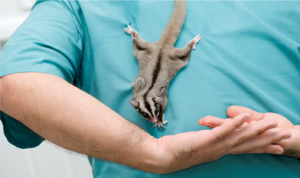 Q: My fiance and I have recently acquired 2 sugar gliders, one is 10 months and the other is 11 months. We got them given to us as a bonding pet for our baby that is due in June. Any advice as to get them bonding better with us because weve noticed they tend to bite now and again. It doesnt hurt or break skin but it wouldnt be good for our babies new ‘little friends’ to be biteing him.
Q: My fiance and I have recently acquired 2 sugar gliders, one is 10 months and the other is 11 months. We got them given to us as a bonding pet for our baby that is due in June. Any advice as to get them bonding better with us because weve noticed they tend to bite now and again. It doesnt hurt or break skin but it wouldnt be good for our babies new ‘little friends’ to be biteing him.
Oh and another question about my cage. It’s about 3 – 3 1/2 feet tall, 2 feet long by 18 inches deep. Is that a good size for them?
A: This is an interesting question. I have heard of sugar gliders bonding well with children, but I don’t know anything about babies.
What I do know is that there is no sure-fire way to make sure your gliders do not bite. Gliders bite for different reasons, being out of fear or curiosity. When they give you little nibbles, it is their way of checking you out (my sugar glider does this to me even after 5 years of bonding). They will want to do this with a baby, I imagine.
Another thing I would be concerned about is that you cannot control what your baby does, either. If your baby goes to grab the glider or does something frightening, the glider could bite your baby out of fear. I would be more worried about this because this will be a hard bite. Also, depending on how well you can groom your glider, I’d be afraid of their sharp nails. If you are going to let the gliders crawl on your baby, your baby could get seriously scratched.
After having said this, I will say I don’t think it’s impossible to have a baby and sugar gliders at the same time. But I would recommend you keep them separate at least until your baby is old enough to understand the dos and don’ts with sugar gliders.
Check out my post about bonding with sugar gliders. I talk a lot about how I bonded with my glider and you can get ideas on how to bond with yours. I have a single glider so my bonding experience will be a little different from yours, but in general the idea is the same. The more time you spend with your gliders and interact with them, the better and faster you’ll bond with them.
I think for now, because your gliders are young, your cage is a fine size. But in a couple of years, you might want to look into getting them something a little bigger, especially if they spend a lot of time in their cage.
I hope this is helpful. Please keep us all updated on how it goes over with your gliders when your baby arrives. Good luck!
 Q: I have a 9 month old male, got him at 6 months, he had never bonded with anyone. He gets up at about 8 pm and goes to bed at about 7 am. I keep him in my shirt pocket all day. When I get him out of my pocket he wants to go right back in, like he is shy. How do I get him to play?
Q: I have a 9 month old male, got him at 6 months, he had never bonded with anyone. He gets up at about 8 pm and goes to bed at about 7 am. I keep him in my shirt pocket all day. When I get him out of my pocket he wants to go right back in, like he is shy. How do I get him to play? Q: I am thinking about getting a sugar glider, but I have some questions. Do you need to get two gliders, because we went to a pet store and he said you need to get two, because apparently they could easily die of depression!
Q: I am thinking about getting a sugar glider, but I have some questions. Do you need to get two gliders, because we went to a pet store and he said you need to get two, because apparently they could easily die of depression! Q: I’m going to be moving into an apartment for college in the summer and I can’t take my cats with me so I was considering buying a sugar glider to keep me company (I get super lonely without a pet around). Do you have any advice for me as far as picking out and caring for my first glider? Things to know for first time owners and stuff like that?
Q: I’m going to be moving into an apartment for college in the summer and I can’t take my cats with me so I was considering buying a sugar glider to keep me company (I get super lonely without a pet around). Do you have any advice for me as far as picking out and caring for my first glider? Things to know for first time owners and stuff like that? Q: A friend of mine just gave me her sugar glider because she no longer had time for it. Now that I have him in my home, I am kind of scared to pick him up out of his cage because I’m afraid he will get away from me. What is the best way/time to pick them up out of their cages? I don’t want him to suffer from depression from not having enough bonding time, but I also don’t want to lose him. Is there anything you can suggest for my problem?
Q: A friend of mine just gave me her sugar glider because she no longer had time for it. Now that I have him in my home, I am kind of scared to pick him up out of his cage because I’m afraid he will get away from me. What is the best way/time to pick them up out of their cages? I don’t want him to suffer from depression from not having enough bonding time, but I also don’t want to lose him. Is there anything you can suggest for my problem? Q: I am considering adopting an adult glider. A friend has one and wishes to give it to me. Will it be more difficult for it to bond than a baby. What other problems might I consider?
Q: I am considering adopting an adult glider. A friend has one and wishes to give it to me. Will it be more difficult for it to bond than a baby. What other problems might I consider?